How gender ideology broke the census

The 2021 census of England and Wales reportedly cost £900m. Amid much fanfare, data on the transgender population was collected for the first time. But the exercise seems to have gone wrong. The question on gender identity may have been misunderstood, giving strange results. The Guardian reported:
“The proportion of people who had a different main language than English and who said they were trans was four times higher than the 0.4% of the population with English as their main language (or English or Welsh in Wales).
“Overall, 13% of people identifying as trans did not speak English well and the London boroughs of Newham and Brent recorded more than double the average proportion of respondents identifying as trans, higher than in Brighton or Cambridge.
“The ONS [Office for National Statistics] admitted ‘the overall impact on the data of any misinterpretation of the question cannot be determined’.”
The UK Statistics regulator has said that it is still considering whether to accredit the gender identity dataset as having ‘accredited official statistics’ status. We wrote to the statistics regulator in November to say that the investigation by the Office for National Statistics (ONS) has been inadequate and its conclusions are not supported.
Our conclusion was that data on gender identity (including the sex of the people identified as transgender) is not fit for purpose. It was driven by the adoption of concepts and questions promoted by lobby groups that seek to replace sex with gender identity.
Last week The Telegraph reported on leaked documents which show how much influence gender ideology has within the ONS.
Why did the ONS get it wrong?
The ONS spent years planning how to collect data on the transgender population. It conducted focus groups and consulted trans lobby groups, but ignored scientists who actually needed to use the data. Instead, it focused on how to avoid upsetting people with a transgender identity.
When you see what’s been going on inside the ONS, this is not at all surprising. ONS staff policies, internal communications and posts on its intranet and staff chat sites show an organisation that has put transgender identities and feelings before everything – including accuracy.
Gender identity rules the roost at the ONS
The ONS’s Gender identity and transitioning at work policy shows how transactivist demands have been prioritised, seemingly with no consideration of the consequences.
“All trans people should be treated according to the gender in which they identify, irrespective of their legal gender status under the Gender Recognition Act 2004.”
“Although not covered by the Gender Recognition Act (2004), ONS accepts that it is good practice to treat a transgender person who does not hold a Gender Recognition Certificate in the same way as a person who does.”
Both these go far beyond the law, disregarding the impact on other employees.
“Any action deemed to constitute bullying and/or harassment on the grounds of transgender, non-binary or intersex status will result in consideration of action under the ONS Disciplinary Policy and Procedure.”
The term “non-binary” is not recognised in UK law or mentioned in the Equality Act, and “intersex” is an outdated term for a range of congenital disorders of sex development. These words are indications that activists wrote the policy. It also refers to “birth gender”: this must mean birth sex.
Complete disregard for all other employees
Employee policies actively encourage men who identify as women to use the women’s facilities, and vice versa.
“ONS recognises that it is up to the employee to decide when they feel comfortable using these facilities.”
There is nothing about the comfort or wishes of anyone who enters a facility expecting it to be single-sex.
The manager’s checklist for supporting a transitioning employee contains a section headed “Use of single sex facilities”. This says:
“Have you agreed when the employee will start to use single sex facilities, such as toilets and changing rooms, appropriate to their acquired gender? This will usually be on the first day of transition.
“If colleagues object to sharing facilities with employees going through transition, the situation should be dealt with through communication, discussion and education. If colleagues persist with unreasonable objections you may need to manage the situation via grievance or disciplinary procedures.”
In other words, anyone who objects to a man in the women’s facilities or a woman in the men’s facilities needs to be educated. If they persist in their objections, they may need to be disciplined.
“All employees have a responsibility to… use correct names and pronouns.”
This is compelled speech.
Concealment is mandated
Extreme secrecy is at the heart of the policy. Someone who transitioned before joining ONS need not reveal or acknowledge this within the organisation. This means that a male can access all female facilities, regardless of the impact on women, and everyone else must – with compelled pronouns – pretend not to see.
Where an employee transitions after joining ONS, all records of their previous “gender” are to be destroyed. Sickness notes do not have to be uploaded to the central system because they would show the reason for absence. Managers must put “any paper documents that cannot be destroyed in a sealed envelope and attach it to a new employee file, clearly marked as confidential, to be opened only if required, by a member of the Employment Relations Team”. This is extreme, meaning that a new line manager might not be aware of an employee’s past performance, absence, sickness or disciplinary records.
An annex to the policy uses activist terminology such as “dead naming” and “cis gender”. The definition of trans is taken from Stonewall (the list of identities that ends with the mysterious “neutrois”). Transphobia is defined as “the fear or dislike of someone based on the fact they are trans, including the denial/refusal to accept their gender identity”. This is a denial of the rights of those employees who do not believe in gender identity. Disagreement is not discrimination or a phobia. It is simply not sharing a belief, and has been shown to be perfectly legal.
Promotion of transactivism on staff noticeboards
The official staff intranet and the less formal, but still regulated, staff Yammer channels carry frequent content promoting transgender matters. It’s not just the infamous post concerned about the wellbeing of transgender colleagues when the census results were queried. Here it is:
November 2023, ONS blog post to all staff
A message of support for colleagues
Three directors, including the Director of Population, worry that the official reviews into ONS’s handling of sex and gender statistics are a threat to the safety of ONS staff.
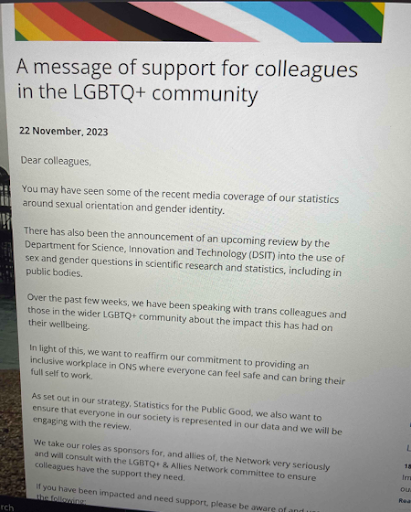
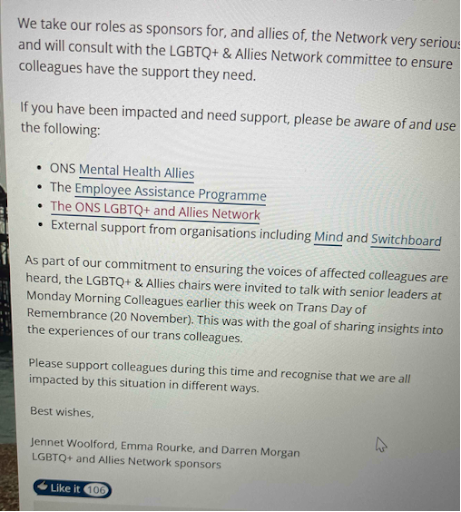
The census failure must have come as a shock, given that the national statistician and head of the ONS, Sir Ian Diamond, in a post for LGBTQ+ history month, celebrated how the census questions on sexual orientation and gender identity had received an “overwhelmingly positive response from LGBTQ+ charities”. This ignored the great concern about the framing of the questions expressed by data users, both before and after the census was conducted.
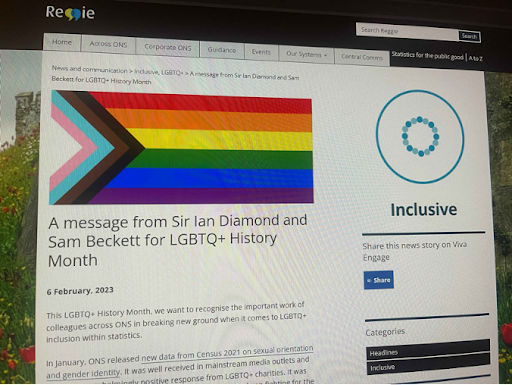
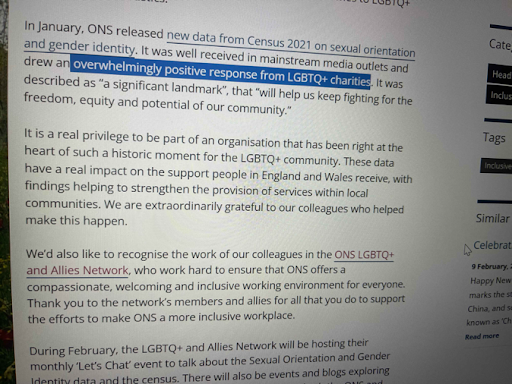
The LGBTQ+ agenda isn’t just for the census
Here are some examples of posts to all 4,000+ staff on the front page of the ONS intranet. They will have been edited and approved by the central ONS comms team (50+ staff).
February 2024, ONS blog post to all staff
Healthcare, experience and history
The LGBTQ+ Staff Network writes a long post on LGBTQ+ history and healthcare, advocates for a ban on conversion therapy, tells us that the female 18th-century surgeon James Barry was a transgender man, and claims that problems with conversion practices “persist to this day”.
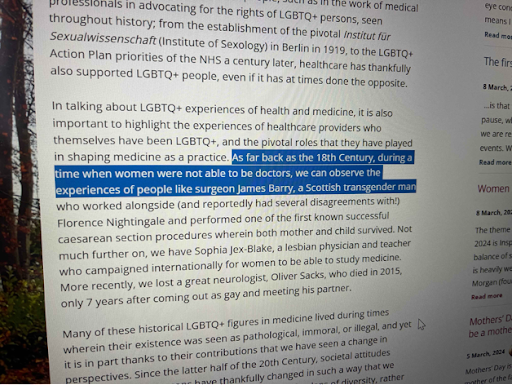

May 2023, ONS blog post to all staff
Keeping LGBTQ+ history in mind
A long post about the Nazis and gender-affirming medical care.
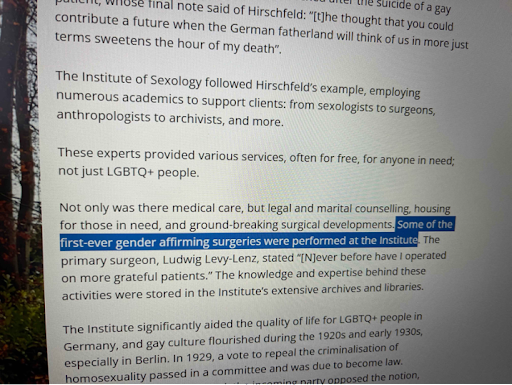
November 2022, ONS blog post to all staff
Faith and Gender
A civil servant in Crime Statistics discusses the various genders in India and the “missing voices” of young Indian transgender Sikhs. The post describes Hijra people, but fails to mention that they are gender non-conforming males, some of whom are forcibly castrated. It is hard to see what this has to do with data collection in the UK.
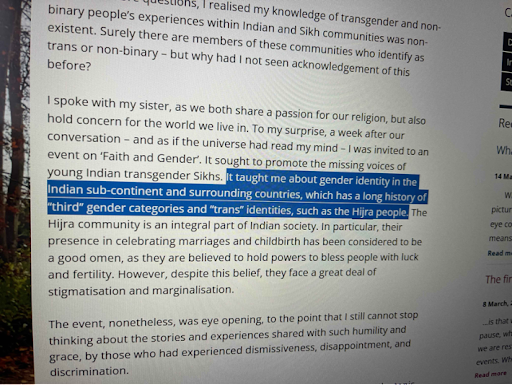
Why it matters
This is a model of how transgender ideology can harm an organisation – not just staff policies and the people who work there, but also the work that it does. The ONS has an authority greater than almost any other institution to decide which concepts are valid and important, and which categories scientists are able to talk about. It is respected around the world. It even has its own international development team that supports developing countries to collect official statistics and helps run their census programs. When the core work of the ONS is distorted by ideology, the ripples spread far and wide.
Government departments, NHS trusts, universities and other organisations that have participated in Stonewall workplace schemes usually claim that these schemes solely concern their behaviour as employers, not their work or their output. But when a BBC radio podcast, Nolan Investigates, looked at Ofcom, the independent media regulator, it found evidence suggesting that Ofcom’s adjudication of broadcast material was shaped by its wish for Stonewall approval.
This evidence from the ONS shows how transactivism has distorted the focus of the ONS and derailed its purpose.
